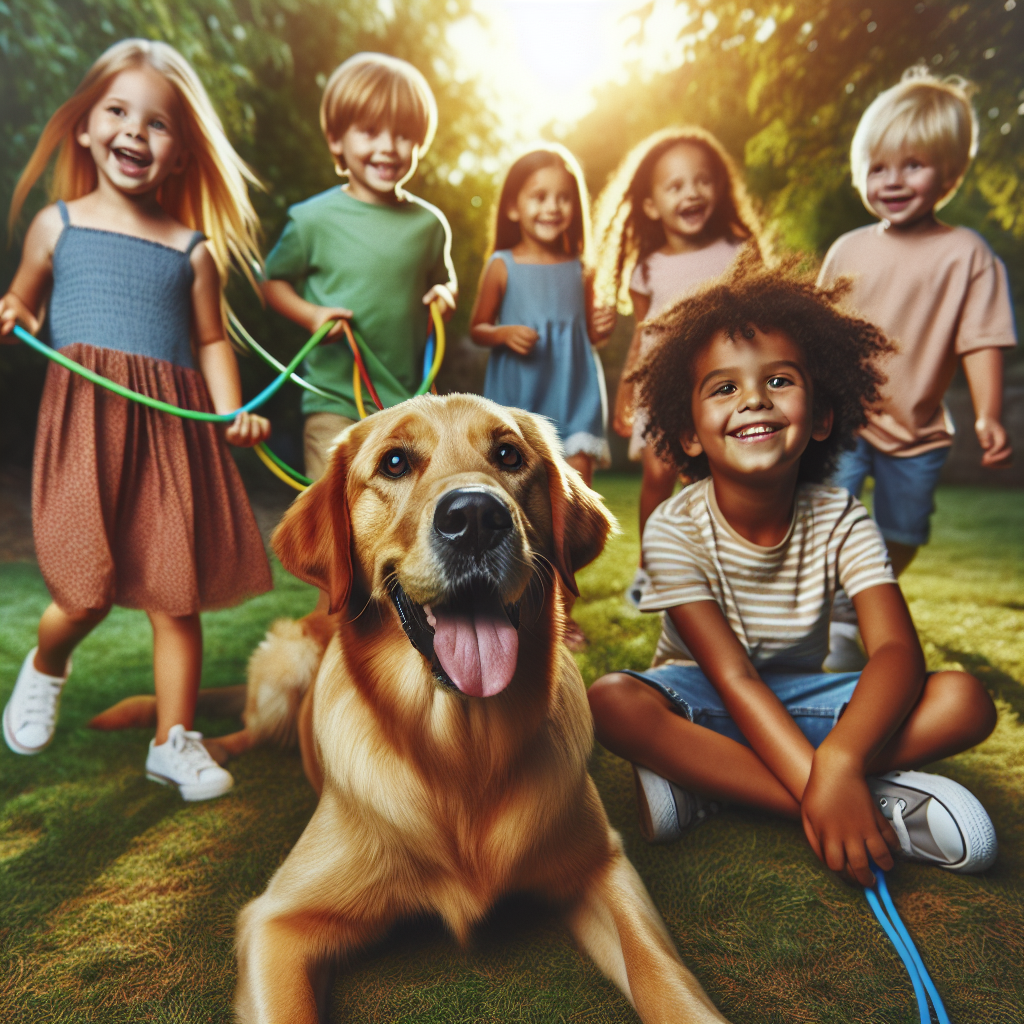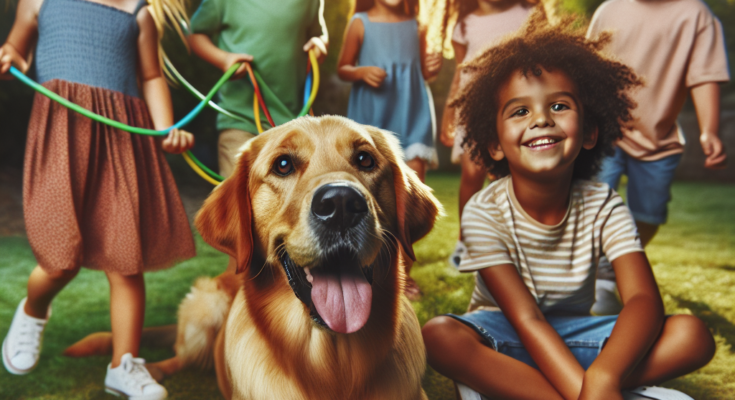Choosing the Perfect Starter Dog for Your Kids: Top Breeds and Tips
Finding the best starter dog breeds for kids is an exciting journey that can enhance family life and teach children valuable lessons in responsibility, empathy, and kindness towards animals. Family-friendly dogs are not just pets; they become cherished companions that contribute to your child’s development. When selecting a dog for children, it’s essential to consider characteristics such as temperament, size, and adaptability to ensure a harmonious household.
Experts agree that dogs that are good with kids often exhibit gentle and playful traits, making them ideal for families. Breeds like Labrador Retrievers, Golden Retrievers, Beagles, and Bulldogs are renowned for their loving nature and compatibility with children. These breeds not only enjoy playtime but also provide a sense of security and companionship, enriching the lives of both kids and adults alike.
Moreover, responsible pet ownership involves understanding how to care for a dog and recognizing the importance of training dogs for families. Teaching children safe interactions with pets helps foster a nurturing environment. Adopting a dog for kids can be one of the most rewarding experiences, allowing children to learn about commitment and care through daily activities like feeding, grooming, and exercising their furry friends.
As you embark on this journey of choosing a dog for children, keep in mind the significance of matching the right breed with your family’s unique lifestyle. Evaluating factors such as energy levels, grooming needs, and potential health concerns will help you make an informed decision. With the right guidance and preparation, your first family pet will undoubtedly bring joy and teach invaluable lessons about love and companionship.

Understanding the Importance of Choosing the Right Dog for Kids
Choosing the right dog for kids is pivotal, as it can significantly influence family dynamics and children’s development. The benefits of having a dog for children are numerous. Dogs can provide companionship, teach children about loyalty, and enhance emotional well-being through their unconditional love. Moreover, engaging with a dog encourages outdoor play and physical activity, which is beneficial for a child’s health.
Factors to Consider When Choosing a Family Dog
When selecting a family dog, several factors should be considered:
- Temperament: Some breeds are naturally more gentle and patient, making them ideal for families with young children.
- Size: Larger dogs may accidentally harm small children during play, while smaller breeds might be more fragile.
- Energy Level: Active breeds can keep up with energetic kids, while calmer breeds may suit quieter households better.
The Role of a Dog in Teaching Responsibility and Empathy
A dog can be an excellent tool for teaching responsibility and empathy. Caring for a pet requires children to learn about feeding, grooming, and exercise, fostering a sense of accountability. Additionally, interacting with a dog can help children understand emotions, as they learn to read a dog’s body language and respond to its needs. This nurturing relationship can instill valuable life skills that last well into adulthood.
Best Dog Breeds for Families with Young Children
Choosing the right dog breed is crucial for families with young children. Here are some of the best options that combine friendly personalities, patience, and adaptability.
Labrador Retriever: The Friendly Family Companion
Labrador Retrievers are known for their friendly and outgoing nature. They are great with kids, making them ideal family pets. Their playful demeanor encourages children to engage in outdoor activities, fostering a strong bond.
Golden Retriever: Gentle and Patient Nature
Golden Retrievers are gentle, loyal, and patient, making them excellent companions for children. Their affectionate nature ensures that kids feel safe and loved, while their intelligence makes training enjoyable.
Beagle: Energetic and Playful
Beagles are energetic and playful, perfect for active families. Their curious and friendly disposition allows them to interact positively with children, making playtime fun and engaging.
Bulldog: Calm and Loyal Protector
Bulldogs are calm and gentle, providing a protective presence for families. Their loyalty and laid-back attitude make them a great choice, especially for families seeking a loving companion.
Poodle: Smart and Adaptable
Poodles are highly intelligent and adaptable, making them easy to train. They come in various sizes, allowing families to choose one that fits their lifestyle while being great with kids.
Cavalier King Charles Spaniel: Affectionate and Great with Kids
This breed is known for its affectionate nature and compatibility with children. Cavaliers are gentle, making them excellent companions for younger kids who need a soft and loving pet.
Boxer: Energetic and Protective
Boxers are known for their playful energy and protective instincts. They thrive in active households and form strong bonds with children, making them loyal family members.
Bichon Frise: Hypoallergenic and Playful
Bichon Frises are perfect for families with allergies. Their hypoallergenic coats reduce allergic reactions, while their playful and cheerful nature brings joy to any family setting.
Key Considerations for Selecting Your First Family Dog
Size of the Dog: How It Affects Living Space and Interaction
When choosing a family dog, consider its size. Large breeds may require more space to move around and play, which is crucial for families living in smaller homes or apartments. Conversely, smaller breeds can thrive in compact spaces and are often easier for children to handle.
Energy Levels: Matching the Dog’s Activity Needs with Your Family’s Lifestyle
Different breeds have varying energy levels. Active families might enjoy high-energy dogs like Labrador Retrievers that love outdoor activities. However, if your family prefers a calmer environment, consider breeds such as Bulldogs or Basset Hounds that require less exercise.
Temperament: Understanding Behavior Traits That Suit Children
The dog’s temperament is essential for a harmonious family life. Friendly and patient breeds like Golden Retrievers are excellent with kids, while more reserved breeds may not interact as easily. Assessing the breed’s behavior traits ensures a good fit for your children’s personalities.
Grooming Needs: Low-Maintenance vs. High-Maintenance Breeds
Grooming requirements can significantly impact your choice. Low-maintenance breeds, such as Beagles, require minimal grooming, making them ideal for busy families. On the other hand, high-maintenance breeds like Poodles need regular grooming, which could be a consideration if time and budget are limited.
Allergies: Choosing Hypoallergenic Breeds if Necessary
If your family has allergies, look for hypoallergenic breeds like the Bichon Frise or Shih Tzu. These dogs produce fewer allergens, making them suitable for families sensitive to pet dander.
Essential Training Tips for Family Dogs
Training a family dog is crucial for fostering good behavior and ensuring a harmonious household. Here are some essential training tips to help your dog thrive.
Basic Commands: Teaching Sit, Stay, and Come
Start with basic commands such as sit, stay, and come. These commands create a foundation for more advanced training. Use short sessions, ideally around 5-10 minutes, to keep your dog’s attention. Consistent practice is key; repeat each command until your dog responds reliably.
Positive Reinforcement: Encouraging Good Behavior
Utilize positive reinforcement by rewarding your dog with treats or praise when they obey commands. This method encourages your dog to associate good behavior with positive outcomes, making them more likely to repeat the behavior in the future.
Socialization: Introducing Your Dog to Different Environments and People
Proper socialization is vital. Introduce your dog to various environments, people, and other animals. This exposure helps reduce anxiety and promotes friendly behavior. Start with controlled situations and gradually increase complexity as your dog becomes more comfortable.
Involving Kids in Training: Building Bonds and Responsibility
Involve your kids in training sessions. This not only teaches them responsibility but also strengthens the bond between your children and the dog. Assign simple tasks, like holding a treat while the dog learns a command, to encourage teamwork and patience.
Ensuring Safe Interactions Between Kids and Dogs
Creating a safe environment for interactions between kids and dogs is crucial for fostering positive relationships and preventing accidents. Here are some essential tips:
Supervision: Always Monitoring Playtime
Always supervise playtime between kids and dogs. This ensures that you can intervene if needed, helping to prevent mishaps and teaching both children and pets how to interact appropriately.
Teaching Kids How to Approach and Handle Dogs Safely
Educate children on how to approach dogs calmly and quietly. They should learn to ask for permission from the dog’s owner before petting and to avoid sudden movements that could startle the animal.
Recognizing Signs of Stress in Dogs
Teach kids to recognize signs of stress in dogs, such as growling, showing teeth, or stiff body language. Understanding dog behavior is vital for ensuring both the safety of the child and the well-being of the dog.
Setting Boundaries: Teaching Children to Respect the Dog’s Space
It’s important to set boundaries and teach kids to respect the dog’s space. Encourage children to give the dog a quiet area to retreat to when it needs a break, promoting a respectful relationship.
Making Your Home Safe and Welcoming for a Family Dog
Dog-Proofing Your Home: Identifying Hazards
To create a safe environment for your family dog, it’s crucial to identify potential hazards around your home. Look for items like electrical cords, small objects that can be swallowed, and toxic substances such as cleaning supplies and certain houseplants. Secure these items out of reach or store them in cabinets. Additionally, consider using baby gates to limit access to areas that might pose risks.
Creating a Comfortable Space for Your Dog
Your dog deserves a cozy spot to relax. Designate an area with a comfortable bed and blankets where they can feel secure. This space should be away from busy household traffic yet close enough to the family to foster bonding. Make sure to keep this area clean and free from clutter to allow your dog to enjoy their resting space peacefully.
Essential Supplies: Food, Toys, and Grooming Tools
Gathering the right supplies is vital for your dog’s well-being. Essential items include high-quality food, durable toys for entertainment and mental stimulation, and grooming tools to keep their coat healthy. Regularly check toys for wear and tear, replacing them to ensure safety and engagement.
Establishing Routines: Feeding, Walking, and Playtime
Consistency is key in a dog’s life. Establish routines for feeding, walking, and playtime to help your dog feel secure and valued. Regular exercise and playtime not only keep your dog physically fit but also strengthen the bond between you and your furry friend, making it an essential part of their daily life.
Fun Ways to Bond with Your New Family Dog
Establishing a close bond with your new family dog is essential for a happy and fulfilling relationship. Here are some fun ways to strengthen that connection through engaging activities.
Outdoor Activities: Hiking, Fetch, and Playdates
Take your dog on outdoor adventures like hiking or playing fetch at the park. These activities not only provide exercise but also allow your dog to explore new environments. Organizing playdates with other friendly dogs can enhance social skills and make for a fun day out.
Interactive Games: Tug-of-War and Hide-and-Seek
Interactive games like tug-of-war can be a great way to engage with your dog while building trust. Alternatively, playing hide-and-seek offers mental stimulation as your dog searches for you. Both games foster cooperation and create joyful experiences.
Crafts and DIY Projects: Making Toys and Accessories Together
Get crafty by making toys and accessories for your dog together. This could include creating a personalized collar or homemade tug toys. Involving your dog in these projects can enhance the bond as they enjoy the fun of new items made just for them.
Participating in Dog Sports: Agility and Obedience Classes
Join dog sports like agility or obedience classes. These activities not only promote fitness but also teach discipline and teamwork. Working together towards a common goal can significantly deepen your relationship and provide a sense of accomplishment.
Encouragement and Final Thoughts on Choosing the Right Dog for Your Family
Choosing the right dog for your family is more than just picking a pet; it’s about building lifelong memories with your child and their dog. The bond formed through playtime, walks, and training can significantly enhance a child’s emotional growth and responsibility. Engaging with a dog teaches kids compassion and nurtures their social skills, creating a foundation for strong relationships.
The joy of pet ownership goes beyond companionship. It offers valuable lessons along the way. Dogs encourage active lifestyles, prompting families to explore the outdoors together. Additionally, caring for a dog instills a sense of duty, as children learn to feed, groom, and exercise their furry friends regularly. Each experience becomes a teaching moment, reinforcing positive behaviors and empathy.
Ultimately, selecting the right breed that aligns with your family’s lifestyle ensures harmony at home. Whether you choose a playful Labrador or a gentle Cavalier King Charles Spaniel, the right dog enriches family life, creating joyous moments that last a lifetime.
Conclusion
Choosing the perfect starter dog for kids is a rewarding journey that enriches family life. Understanding the importance of selecting the right breed ensures compatibility with young children. Popular choices like Labrador Retrievers, Golden Retrievers, and Beagles offer gentle and playful temperaments. Key considerations, including energy levels and grooming needs, play a crucial role in making an informed decision. Essential training tips and ensuring safe interactions foster a loving environment. By making your home safe and welcoming, you create a nurturing space for your new furry friend, paving the way for joyful bonding experiences.
References
- Easy Way Pets. (n.d.). Good Dog Breeds for Kids: Find the Perfect Pup for Your Family
- iHeartDogs. (n.d.). Top 10 Best Dog Breeds For Kids
- Dog Breed Pro. (n.d.). 20 Best Dog Breeds for Kids
- Cadet Pet. (n.d.). Good Dog Breeds for Kids
- The Animal Central. (n.d.). The Ultimate Guide to Choosing the Best Dog Breeds for Children
- Kennel Hub. (n.d.). The Best Dog Breeds for Families with Kids
- iHeartDogs. (n.d.). Top 11 Family-Friendly Dog Breeds: Puppies That Love Kids
- Petful. (n.d.). Effective Family Dog Training: Tips to Help Your Dog Thrive in a Family. Retrieved from https://www.petful.com/behaviors/family-dog-training/
- Caring for Pets. (n.d.). 12 Dog Training Tips That Are Truly Helpful. Retrieved from https://www.caringpets.org/dogs/12-dog-training-tips-that-are-truly-helpful/
- Dogs Trust. (n.d.). Top 10 dog training tips. Retrieved from https://www.dogstrust.org.uk/dog-advice/training/techniques/top-ten-dog-training-tips
- What Can My Dog Eat. (2024). 13 Fun Ways to Strengthen Your Bond with Your Dog.
- PetHelpful. (2024). 6 Ways to Bond With Your Dog and Learn Something New.
- Sploot Vets. (2024). 8 Amazing Ways to Bond with Your Dog [Complete Guide].
- Animal Wellness Magazine. (2024). Top 10 ways to build a bond with your dog.
- Dogster. (2024). How to Bond With Your Dog: 9 Ways to Strengthen Your Connection.
- Bil-Jac. (2024). How to Bond with Your Dog: 12 Proven Ways to Strengthen Your ….


